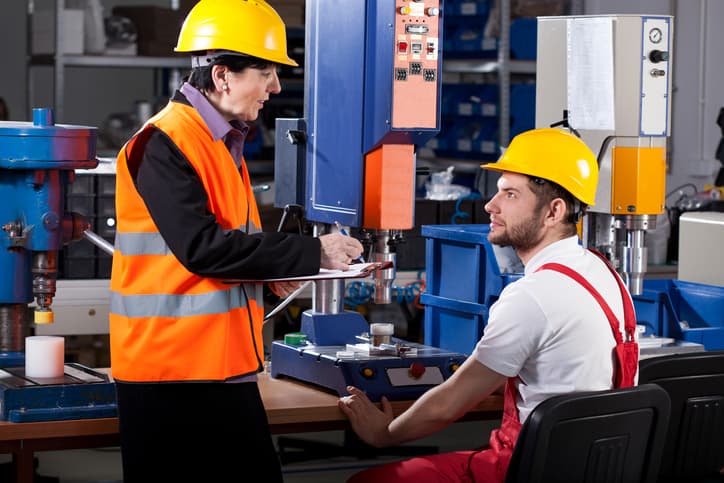BLOG
How to keep health and safety interesting in the workplace
Health and safety is just one of those topics that has acquired the unfortunate reputation of being, well, boring.
The way health and safety training is delivered to employees has a lot to answer for – often, courses are characterised by an overabundance of legal facts and information that has little relevance to employees’ day-to-day responsibilities.
Blog

To make matters worse, the focus is largely negative, alarmist and can feel like you’re getting a telling off, with a lot of “if you don’t do X, the consequence will be Y” (where Y is something profoundly undesirable). Rather depressingly, on the IOSH forum, one health and safety trainer said that their role was to “suck the life out of people”. Yikes.
That said, training is not the only culprit. The way that employers approach their day-to-day management of health and safety has a significant bearing on the perception of health and safety as dull and prescriptive. To put it simply, if management views health and safety as boring and a burden on their time, you can bet this will inevitably rub off on employees.
The coronavirus pandemic has brought the importance of good occupational health and safety firmly info focus; all organisations know that this is a top priority, yet as time goes on and restrictions continue, apathy can creep in and employers will need to find ways to keep health and safety at the forefront of everyone’s minds in order to maintain a safe workplace.
So, if you’re battling disinterested and disengaged workers and an overall negative perception of health and safety in your workplace, here are our tips to turn things around.
1. Start by changing the perception of your management team
If you can get your management team to feel positively about health and safety and to see it as worthwhile, then this will set the tone for all staff and put you in a far better position to change the perception of employees.
Managers at all levels need to shift their focus from pessimism and complaining to recognising positive action and celebrating good health and safety performance, in whatever way you feel will most resonate with employees (whether this is a simple thank you or a small reward).
Very often, the root of the problem is that managers only address the negative aspects of health and safety – they will be quick to give an employee a ticking off for not wearing correct PPE, but it almost never happens that an employee who wears the correct PPE receives positive feedback.
Remember, any change should be led from the top and filtered down through the workforce.
Safety Culture Survey
Created by our team of highly-qualified consultants, our Health & Safety Climate Survey is an online tool designed to uncover employees’ attitudes and perceptions to workplace health and safety and provide you with an objective measure of your health and safety culture
Focus on the positive, ensure feedback is constructive and give praise where it’s due. Where non-compliance needs to be dealt with, approach the situation with an optimistic, can-do attitude and focus on finding the solution rather than the inconvenience of the problem.
2. Engage employees in day-to-day safety management
Health and safety can often feel like a restraint – something that’s imposed by management that exists to make carrying out an employee’s role more difficult.
However, listening to employees and involving them in health and safety decision making – rather than just enforcing rules and procedures on them – can make all the difference to employees’ attitudes to health and safety.
This change in perception may come from employees having a better understanding of the reasons behind a specific process or procedure, or simply the fact that they feel they have contributed to the decision.

In practical terms, employees can be engaged by sitting on the health and safety committee as employee representatives, being members of a team working on a specific project, or taking part in risk assessment. Getting employees involved is a great way to get them to take ownership of and genuinely care about maintaining the systems you have in place.

3. Integrate health and safety into your overall business performance measures
Health and safety is often seen as something that sits on the outside of your core business objectives.
When you really think about it, to treat it as a separate entity makes little sense, as it’s a well-known fact that health and safety performance has an impact on business performance. For example, a serious accident could have a profoundly negative impact on annual profitability, among other metrics.
By fully integrating health and safety into your overall business objectives, it becomes part of everyday work instead of being seen as an unwelcome distraction from an employee’s role.
The use of health and safety software will help to support day-to-day safety management and ensure that anyone tasked with managing health and safety has a clear indication of how they are performing. Our award-winning risk management software, MyH&S, lets you assign responsibilities for tasks and monitor your risk status in real time.
4. Celebrate success
Another way to elevate health and safety to the same level as other business areas is to celebrate good safety performance in the same way as you would celebrate good commercial or production performance.
Some examples of how to do this may include a monthly/quarterly/annual award for the best near-miss report or best department health and safety performance. You could even use a visual dashboard to display safety KPIs, accidents reported and days without incidents to really keep this front of mind and get everyone working towards the collective goal of an accident-free workplace.
All of this will go towards raising the profile of health and safety across the business.
5. Rethink how you deliver training
Even with the best will in the world, reciting statistics and legislation can cause employees to zone out and is unlikely to have lasting results. You want to make sure that training is delivered in a way that makes employees pay attention and remember and heed the content of the training. You should:
Ensure training is relevant. There’s no point in reeling off information that has no practical use to employees as this will just overwhelm them unnecessarily. Where possible, relate information to the specific challenges involved in an employee’s role and explain how legislation applies to them. You may wish to consider providing training to smaller groups of colleagues so that you can maximise relevance and impact.
Get employees up and doing Instead of presenting a long list of facts, use this as an opportunity for interaction and participation. This could be done by designing some workshop time, turning information into a game, quiz or ‘myth busters’ exercise, or simply encouraging employees to share their experience and open up a discussion. The Health and Safety Executive (HSE) has a section designed around health and safety myths, which might be a fun tool to get a conversation started.

The right training can make all the difference to how health and safety is perceived and managed.
Share some success stories. Conversation surrounding health and safety and its implications shouldn’t be all doom and gloom. Think about occasions where accidents have been prevented through good practice.
Show rather than tell. When designing training, look for opportunities to demonstrate what you’re talking about rather than simply stating facts. This could be as simple as taking delegates out into the workplace to point out the location of fire exits and assembly points and where your first aid kit and accident book is kept rather than just stating this information in the training room.
Keep your audience in mind. Finding what will have the biggest impact is all about knowing your staff. Some may appreciate fun, some may prefer a direct approach, and some may respond better to something more serious – the key is in finding the right balance. Rounding off interactive elements with a frank discussion about why what they have learnt is important is one way to achieve this.
Final thoughts
There are a number of ways to dismantle the ‘boring’ reputation that health and safety often acquires, but two principles are essential: a management team that shows commitment and are positive about health and safety, and employees that are engaged and taking part.
In truth, meaningful health and safety won’t always be fun or appealing; it’s about ensuring people don’t get hurt. Employers should be upfront in this regard – sure, health and safety may not be the most exciting part of an employee’s role, but that doesn’t make the consequences of poor practices any less real. Plus, with a little imagination, employers can find more engaging ways to drive the message home.
Make health and safety everyone's business in 2021
If create a positive health and safety culture is a top priority for your organisation this year, our experienced safety specialists can help you to explore different approaches, including a Behavioural Safety Programme, Safety Culture Survey, Mock Trial and more. For more information and to discuss your specific needs, call 0345 226 8393.
Sign up for the latest news & insights
Resources
Latest News & Insights

Work from wherever? | Things to consider before allowing employees to work from abroad
BLOG Written by Alexandra Farmer on 25 May 2022 A few years ago, the idea of working from anywhere in the world seemed like a pipe dream.

Reduced workforce? Here’s 5 health and safety areas you need to revisit
BLOG Written by Charles Spencer on 18 May 2022 In 2022, a growing number of businesses have moved, or are in the process of moving,

Fee for Intervention | Why health and safety breaches could cost your business more in 2022
BLOG Written on 16 May 2022 It’s a well-known fact that poor health and safety practices cost businesses money. And with the HSE recently announcing yet another

Remote work isolation | How employers can help combat loneliness
BLOG Written on 12 February 2021 While the benefits of remote work are seemingly boundless, often overlooked is the isolation and disconnectedness that it can

Time off for getting married or moving house
BLOG Written on 12 May 2022 There are certain big life events that can sometimes get in the way of work. Whether it’s a wedding

Recent cases highlight continued work at height failings
BLOG Written on 6 May 2022 Working at height continues to be the leading cause of work-related fatality. According to most recent HSE figures, these

Managing organisational change | How to keep people happy
BLOG Written on 28 February 2022 In the direst of circumstances, humanity’s true capacity for adaptation and perseverance can be realised. Where the business world

5 ways to combat 2022’s recruitment challenges when you can’t pay more
BLOG Written by Christian Vincent and Hannah Copeland on 15 April 2022 In 2022, recruitment and retention are fast becoming employers’ biggest challenges. With people

A war of words | Managing employees’ political views on the Russia-Ukraine conflict
BLOG Written by Lesley Rennie on 13 April 2022 The war in Ukraine, and the daily news reports of fatalities, continues to spark conversation in


